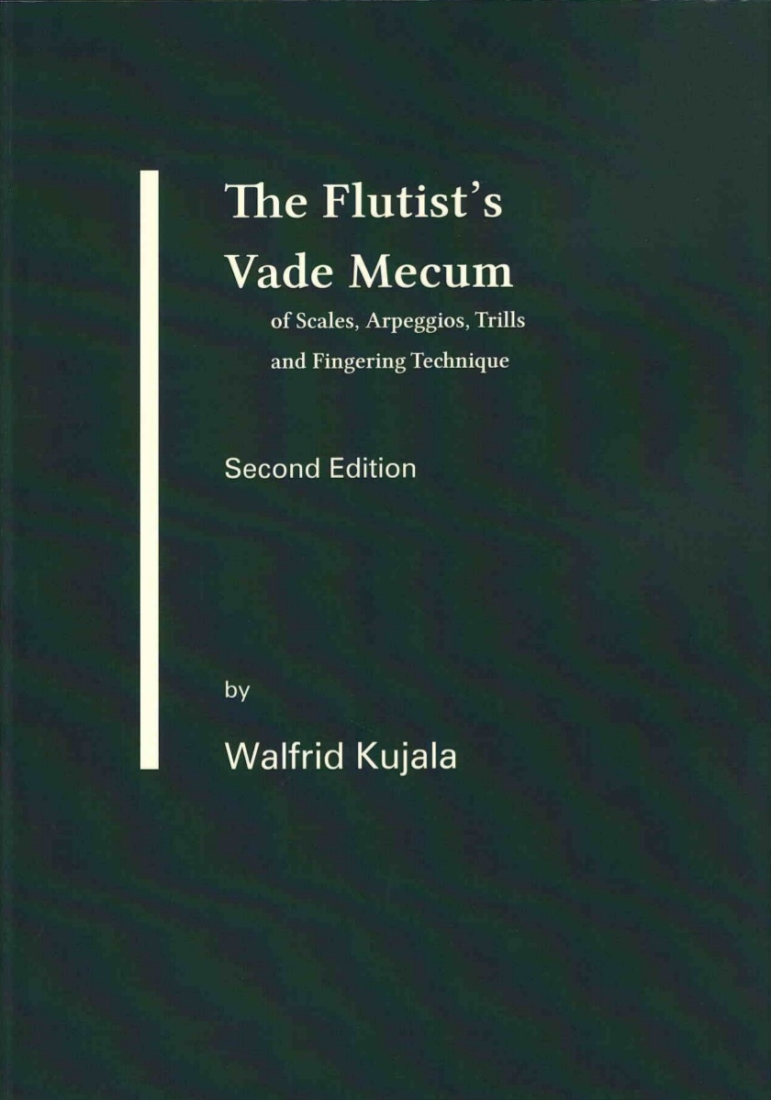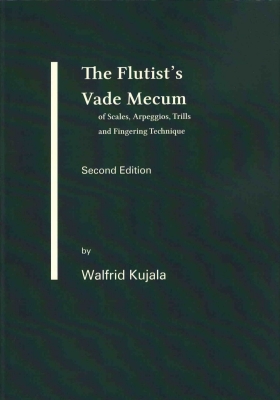Opens in a new window
Progress Press The Flutist's Vade Mecum of Scales, Arpeggios, Trills and Fingering Technique (Second Edition) - Kujala - Flute - Book

- Composer/Author: KUJALA, WALFRID
- Instrumentation: FLUTE
- Model # FVM
Format: Book
Instrumentation: Flute
A few words from WALFRID KUJALA about his Vade Mecum:
The Flutist's Vade Mecum, Second Edition, is a greatly expanded, all-encompassing approach to the study and perfection of scale, arpeggio, trill and finger technique. As the author explains in the introduction of this 135-page volume, "This book is intended not just for the initial learning of scales and arpeggios but for permanent and ongoing improvement of this material through diligent review. Each section is supplied with advice regarding the most appropriate practice methods (10 pages of explanatory text). Think of this Vade Mecum ("Go with me" in Latin) as a steady companion, always available for review and renewal."
In addition to the opening 18-page core section devoted to basic major, minor, whole-tone and chromatic scales, major and minor broken 3rds (including their inversions), the four triads, and diminished and dominant seventh chords, the Vade Mecum also highlights the following topics:
- Regular coverage of the extremes of the flute range (low B, C, C# and altissimo B, C, C#, and D).
- Expanded vocabulary of scales, including modal, pentatonic, octatonic, blues and Hungarian minor (17 pages).
- Specific instruction on the use of alternate and "facilitating" fingerings.
- Explicit notation of wide-ranging articulations and dynamics in the "Basic Scales and Arpeggios" section.
- The use of five and seven-note groups, and odd meters.
- Broken 4ths, 5ths and 6ths and their inversions, and chromatic broken 3rds (8 pages).
- All triads and 7th chords presented in regular, inverted and broken form (4 pages).
- Learning to make accurate rhythmic changes through "composed" accelerandos and ritardandos of scales (4 pages).
- Trill exercises featuring a "measured" trill approach (3 pages).
- NEW: Extended interval exercises for "attaining defter fingers and a more supple embouchure" (15 pages).
- NEW: "La Scala Kujala", 10 pages of scale phrases excerpted from solo works, and organized into ongoing patterns.
- Chromatic expanding interval studies (5 pages).
- Chromatic scales in quintuplets and septuplets (4 pages).
- Alternating minor and major intervals built on chromatic sequences of 2nds, 3rds, 4ths, 5ths, 6ths and 7ths (5 pages).
- Excerpts from Bach, Beethoven, Mendelssohn, Mozart, Poulenc, Prokofiev and Ravel, with special fingerings (4 pages).
- NEW: Short etudes based on chord progressions from various orchestral passages, with complete chord analysis (10 pages).
- Broken chromatic minor and major 3rds.
- 4-note and 5-note scale "tops".
The first edition appeared in 1995, while this expanded Second Edition (44 pages longer!) was first issued in 2012.
"A refreshing skeptic to the dogmatic proponents of 'one note, one fingering', Kujala enjoys, as I do, devising alternate fingerings for quality, smoothness, intonation, and, I suspect, for fun... Above all, Kujala is a scientist of the flute, a thorough researcher, an experimenter, and a tolerant author who is not obsessed with certitudes, either his own or those of prior generations." - Michel Debost, reviewing the 1st edition in Flute Talk, Feb. 1996
The sound files (Media tab - from publishers website) are intended to demonstrate what the exercises sound like when executed with absolute perfection, with no "give-and-take" to accommodate difficult passages, the challenges of breathing, or the more treacherous pitfalls in sound production at the extreme ranges. A live performer will, of course, apply a tasteful "give-and-take" to facilitate his or her own statement of a piece. But often performers will decide that a ritard is "musical" when in fact it is merely accommodating a difficult technical passage. These habits can form without our realizing it, and these sound files serve as a check on our perception in this regard.
The fluidity of these passages in the audio files will hopefully encourage flutists to perfect their passages with strict discipline throughout. Having achieved absolute control of the execution of a part, the musician will then apply ritards, accelerandos, tenutos and the entire arsenal of expressiveness in a language that is truly good musicianship, and not merely speed bumps in the momentum to accommodate more challenging passages.
Some would argue that so much emphasis on metronomic perfection stifles expressiveness. But we believe that absolute control of one's technique "tool box" instils comfort to the degree that the technique becomes a subconscious support beam, and not the surface image, of a more expressive performance. The only way one can avoid thinking too much about technique is to master it.
The audio excerpts are an exact electronic realization of the examples contained in the book. They were created by Philip Rothman and NYC Music Services using Sibelius 7 and XSample Chamber Ensemble sample library.
Media
1 Bb scales, broken 3rds and arpeggios
Press play to listen
2 La Scala Kujala No. 12, p. 40
Press play to listen
3 La Scala Kujala No. 27, p. 44
Press play to listen
4 Attaining Defter Fingers and a more Supple Embouchure, p. 47
Press play to listen
5 Composed Accelerandos - C Major Scale, p. 72
Press play to listen
6 Pentatonic Scales on C, p. 92
Press play to listen
7 Blues Scales on C, p. 92
Press play to listen
8 Modal Scales, pages 98-99, bars 171 - 205
Press play to listen
9. Haydn Symphony No. 101, p. 116
Press play to listen
10 Beethoven Symphony No. 7 - 4th mvt, p. 119
Press play to listen
11 Beethoven Serenade, Leonore No. 3, Poulenc and Ravel
Press play to listen
Q & A
There are currently no questions for this product.
Reviews
There are currently no reviews for this product. Be the first to write one!





